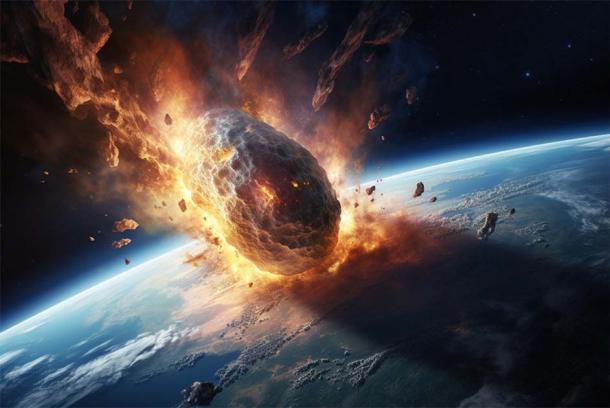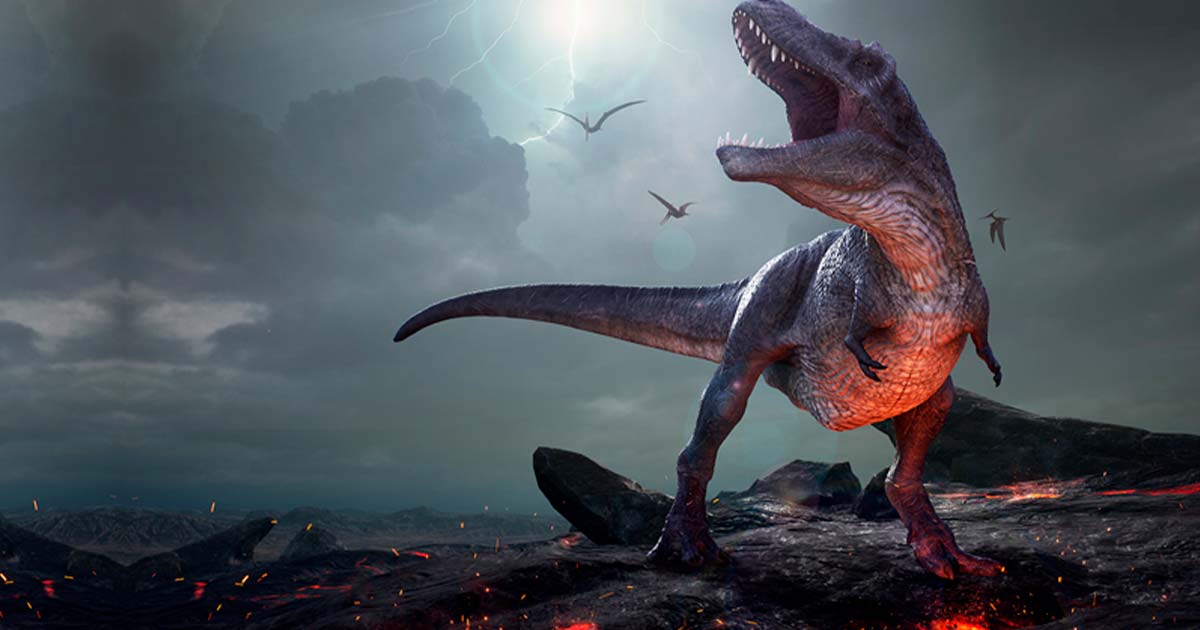Pulverized Rock Dust Killed the Dinosaurs, New Study Says
As enduring as the mighty dinosaurs were, they couldn’t survive the catastrophic climate disaster set off by the crash of a large asteroid into the ocean off the coast of the Yucatan Peninsula in Mexico approximately 66 million years ago. There have always been questions about how exactly the extinction of these huge creatures unfolded following the asteroid strike, and a study published in the journal Nature Geoscience has shed new light on why the dinosaurs were doomed as a result of this incredibly violent and destructive event.
As this exciting new study shows, it seems the dinosaurs were ultimately done in by the collapse of the food chain as a whole following this calamity, which turned the Earth into a vast wasteland and nearly wiped out all life on the planet for good.

Scientists have linked the extinction of the dinosaurs to a catastrophic asteroid which crashed off the coast of Mexico. But a new study sheds light on exactly why they would have died. (Boraryn / Adobe Stock)
The Chicxulub Asteroid: The “Death” of the Sun and the Dinosaurs
The Chicxulub asteroid that collided with the Earth in 66 million BC was responsible for the complete extinction of 75 percent of all plant animal and plant species. Scientists who’ve looked into climate change and extinction scenarios related to this cosmic episode have focused on the role that high concentrations of atmospheric sulfur may have played in making the Earth virtually unlivable.
Known to be the largest astronomical body to ever crash into the planet, the Chicxulub asteroid left an impact crater in the shallow waters of the Gulf of Mexico that was a stunning 112 miles (180 kilometers) wide. As a result of this powerful collision, somewhere between 30 and 500 gigatons of sulfur were released into the Earth’s skies.
- THAT Asteroid Only Accelerated Inevitable Dinosaur Extinction
- Studies Begin on a Crater That May Explain the Dinosaur Extinction 65 Million Years Ago
This is an unimaginably massive quantity of this element, which turned into sulfate aerosols when exposed to other gases in the atmosphere. These thick gases were distributed far and wide across the planet. Combined with the soot from roaring wildfires, they prevented so much of the sun’s heat from reaching the surface that global temperatures fell from between 3.6 and 14.4 degrees Fahrenheit (two and eight degrees Celsius) depending on the location.
Needless to say, temperature declines of this nature would have been deadly to cold-blooded reptiles like the dinosaurs. Based on this obvious fact, it had seemed reasonable to conclude that the sulfur-induced global cooling was the decisive factor in causing their extinction.
Were Dinosaurs Actually Killed By Dust?
But in their Nature Geoscience paper, a team of earth scientists and archaeologists from Belgium, led by planetary scientist Cem Berk Senel from the Belgian Royal Observatory, proposed an alternative mechanism that they believe was the key factor behind the Chicxulub mass extinction event.
These scientists link the loss of the dinosaurs and other flora and fauna to the effects of fine dust made from rock pulverized at the asteroid impact site, which would have been ejected high up into the earth’s atmosphere. Because of the thickness of the dust layer, the planet’s surface was plunged into severe darkness for a period of two years, as the sun’s light could only penetrate the dust in limited quantities.
While the temperature changes the planet experienced were bad, the loss of surface sunlight was even more devastating, the Belgian scientists assert. Without sunlight the process of plant photosynthesis would have instantly halted everywhere, putting all plant life on the planet in immediate peril.
“Photosynthesis shutting down for almost two years after impact caused severe challenges (for life),” study lead author Cem Berk Senel explained in an interview with CNN. “It collapsed the food web, creating a chain reaction of extinctions.”
In photosynthesis, plants harvest sunlight and use it to metabolize water and carbon dioxide, producing energy for their own use while releasing oxygen into the atmosphere. The process is essential to life, and without it individual plants and entire plant species would have died off very soon after the asteroid impact.
Meanwhile, the animals that relied on those plants for sustenance would have died out as well. Plant-eating animals would have been the primary or exclusive food sources for meat-eating predators, meaning that when the plant eaters died the meat eaters would have also been doomed.
Since the loss of sunlight was significant enough to squelch photosynthesis for about two years, this would have inevitably led to the extinction of most of the living creatures on the planet—including the dinosaurs—in the ocean as well as on land (the food chain in the ocean starts with plants like plankton that grow and reproduce close to the surface of the water, where they normally get enough sunlight to survive).
Darkness Falls—but Somehow, Life Still Endures
The results of this enlightening new study emerged from the creation of a complex computer model designed to simulate the climatological effects of the Chicxulub asteroid strike. In addition to recycling older data related to ancient climate change to produce this model, the Belgian researchers also used fresh results obtained from studies of sediment samples removed from the Tanis fossil site in North Dakota in the United States.
These samples were especially relevant to the creation of the computer model, since they revealed specific information about what the climate was like at that location over a 20-year period immediately following the asteroid impact.
The newly studied samples were loaded with fine silicate dust particles, which were first created and then propelled into the atmosphere by the direct force of the asteroid hit. According to the Belgian researchers, the concentrations of silicate dust found at the Tanis site suggested the dust may have remained in the atmosphere for up to 15 years, before it finally fell back to the ground. Notably, in the first two years following the asteroid strike the dust concentrations in the atmosphere would have been dense enough to block out tremendous quantities of sunlight.
- Fossilized Leg of Dinosaur Ripped Off by Catastrophic Asteroid Impact Found
- 66-Million-year-old Deathbed Linked to Dinosaur-Annihilating Meteor
“It had been long assumed that the main killing mechanism was extreme cold following the Chicxulub impact, but of course the cessation of photosynthesis after impact is a mechanism itself,” Senel said. “Within a few weeks, months (of the impact), the planet underwent a global shutdown in photosynthesis, which continued for almost two years during which photosynthesis is completely gone. Then it starts getting back to recovery after these two years… Within three to four years, it reaches a complete recovery.”
This recovery is a testament to the resiliency of life. It is almost a miracle that anything survived, given how devastating the impact of the giant asteroid actually was. But the 25 percent of species that endured wouldn’t have included many types of dinosaurs, and any that remained would have been living on borrowed time. The dramatic change in the Earth’s ecosystems that resulted from the asteroid strike simply wouldn’t have been able to sustain them for a prolonged period. It would have been too cold and food would have been too scarce.

Representational image of a dinosaur fossil. (trafa /Adobe Stock)
Without the Global Dust Cloud, Could Some Dinosaurs Have Survived?
Alfio Alessandro Chiarenza, a paleontologist from Spain contacted by CNN, commented on the profound implications of this new study. “The main takeaway from this paper is that it provides more precise constraints on the composition, properties, and duration of the fine dust component ejected from the impact site, which contributed to the global darkness during the impact winter,” he stated.
“This new information enables us to investigate the processes and duration more rigorously, shedding light on the mechanisms behind the blockage of solar radiation, resulting in photosynthesis shutdown and a significant drop in temperatures below the habitable conditions for example for non-avian dinosaurs.”
It's possible that even without the loss of photosynthesis, the plunging temperatures would have been enough to kill off most of the dinosaurs. But it’s also conceivable that a few of the hardier species might have held on, if they lived close enough to the equator for temperatures not to have plummeted un-survivable levels.
So in the end, the collapse of the food chain caused by the blockage of sunlight was the decisive factor that ensured dinosaurs would be long gone by the time human beings first appeared on the Earth between 200,000 and 300,000 years ago. We only know about them because of the fossils they left behind, which have helped us recreate the time when these astonishing creatures were the undisputed rulers of the planet.
Top image: What was the true cause for the extinction of the dinosaurs? Source: Herschel Hoffmeyer / Adobe Stock
By Nathan Falde

















